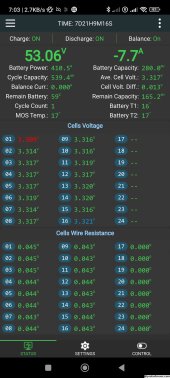MisterSandals
Participation Medalist
What BMS do you have? Are you confusing this with balancing?Not sure how I could turn equalizing off..
3.45Vpc with some absorption is fully charged so you are not too far off. All the weird chit always happens to cell 1 so lets not address that yet.Mostly 3.43V I guess, some maybe 3.45V ? Cell 01 being 3.40V actually.
You 3.60V overvolt is a little low, but workable. What is your top charge voltage and what is battery voltage when cell 16 over volts?




